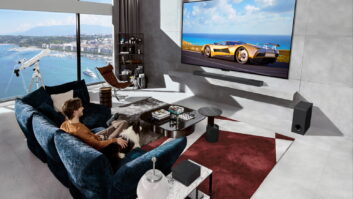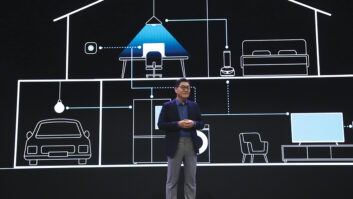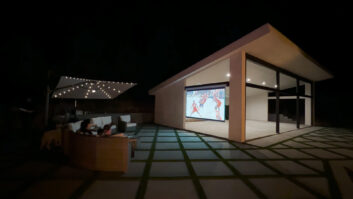The Big Challenge of New Audio Formats is Where to Put Speakers

Anthony Grimani ([email protected]) is president of Performance Media Industries, with offices in Novato and San Anselmo, CA. Say what you will about our industry, but it is not afraid of new technology. The latest advance is coming on the audio side in the form of increased spatial resolution. This is just a fancy way of saying that we’re adding more channels to enhance envelopment and the ability to precisely place sound anywhere in the acoustic space. Soon we’re going to see anywhere from 11.1 to 30.2 discrete channels in home theaters, with even more possible. Folks, that’s a lot of speakers, amplifiers, and EQs to sell, install, and calibrate.
Most new audio formats trickle down from the cinema world, and next-generation surround sound is no exception. Right now, Dolby Atmos and Auro 11.1 are battling it out for cinema supremacy. Atmos is an object/vector-based system that allows mixers to position effects in an XYZ space. The surround processor then automatically tracks them through the correct channels–up to 64 are possible. Most of these new channels provide individual feeds to existing surround speakers and new rows of ceiling speakers, but–more importantly–five screen channels are available once more. Auro 11.1 sticks with a more traditional channel-based approach but ratchets up the number. The new channels supply an additional layer of height speakers above the current main channels to stretch the sound field vertically. Further enhancement is provided by a top channel in the center of the ceiling. Several other formats, such as NHK 22.2 and IOSONO are also jockeying for position.
How are we going to deliver all those channels inside the limited 7.1 framework of HDMI and current codecs? HDMI 2.0 supports up to 30.2 channels, and Dolby is working on a way to layer Atmos into the existing Dolby TrueHD bitstream. Auro feeds its format down a 24-bit PCM pipeline by using the four least significant bits in each channel to encode the new height layer. This makes sense, as those bits only serve to lower the noise floor beyond what is achievable in the rest of the system electronics and room.

Most new audio formats trickle down from the cinema world, and next generation surround sound is no exception. Right now, Dolby Atmos and Auro 11.1 are battling it out for cinema supremacy.
The big challenge for us will be where to put speakers. You should check out documentation for the HDMI 2.0 spec to see where things could end up. Meanwhile, I would prioritize two additional screen channels between the center at zero degrees and the existing L/R speakers, and locate these at about +/-12 degrees. This allows much smoother panning for off-axis listeners without generating giant comb filters from phantom imaging. Height channels above the LCR at about 30 degrees vertical elevation are also important. I’d like to see wide channels at about +/- 60 degrees, direct and diffuse surround channels at +/-90 degrees, additional surround channels at +/-120 degrees, and back channels at +/- 170 degrees (or a single back channel at 180 degrees). Ceiling channels should consist of two rows from front to back, with the speakers spaced apart along the ceiling in similar fashion to the surround speakers down the sidewalls. Displacement of the ceiling speakers from directly above a central listener should be 10-20 degrees.
There are a few things you need to know in the short term. First, these formats aren’t necessarily compatible in terms of channel deployment. Before you go wild pasting someone’s recommended speaker layout into your latest design, check around. Most of these formats have common elements. Those are the most likely to actually end up being widely adopted. Next, these new channels pose a threat of increasing the annoyance and distraction factor. We’re adding a lot of sound that doesn’t come from the screen. If mixers go overboard throwing effects around, things could get messy. Your clients may complain that it’s just too much noise. Here, we’re ultimately at the mercy of the production community. Finally, surround processors don’t currently support these new formats (although products are in development). That doesn’t mean you should wait to install the additional hardware. Even now, Dolby ProLogic IIz, DTS Neo:X, and Audyssey DSX offer matrix solutions to light up additional front height and wide channels. I recently commissioned my tech editor, Chase, to evaluate these post-processing schemes, and he returned a strong recommendation that they be included in new designs–despite a few teething problems.
Chase Walton contributed to this column.







